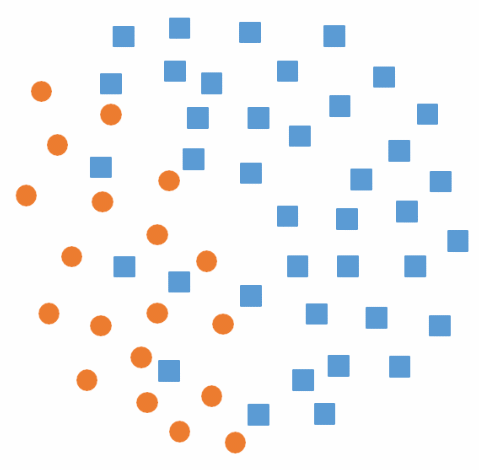
By Saeed Mirshekari
September 4, 2023


Access O'Mentors
Top Data Scientist Mentors from Fortune 500 Companies excited to help you out 1-on-1!
1️⃣ Explore freely
→
2️⃣ Apply confidently
→
3️⃣ Pay securely
→
4️⃣ Book instantly
Navigating the Imbalanced Data Dilemma: A Deep Dive into Oversampling
In the world of data science and machine learning, not all datasets are created equal. One common challenge that often arises is dealing with imbalanced data, where one class significantly outnumbers the others. This imbalance can skew model performance and lead to suboptimal results. Enter oversampling—the technique that can level the playing field. In this comprehensive guide, we'll explore imbalanced data, why it's a problem, and how oversampling can help. Whether you're a data science enthusiast or a junior practitioner, this article equips you with the knowledge and tools to tackle this crucial aspect of data preprocessing.
Table of Contents
-
Understanding Imbalanced Data
-
The Consequences of Imbalance
-
The Oversampling Solution
-
Techniques for Oversampling
- Random Oversampling
- SMOTE (Synthetic Minority Over-sampling Technique)
- ADASYN (Adaptive Synthetic Sampling)
-
Choosing the Right Oversampling Technique
-
Implementing Oversampling in Python
-
Evaluating the Impact of Oversampling
-
Real-World Examples
-
The Pitfalls of Oversampling
-
Conclusion
Understanding Imbalanced Data
In many real-world scenarios, imbalanced data is the norm rather than the exception. Consider, for example, credit card fraud detection, where fraudulent transactions represent a minuscule fraction of overall transactions. Or medical diagnosis, where rare diseases occur far less frequently than common ones. The majority class (negative class) significantly outweighs the minority class (positive class) in these cases.
Here's why this poses a problem:
- Bias in Model Training: Machine learning models tend to be biased toward the majority class because they are optimized to minimize the overall error. As a result, they may perform poorly on the minority class.
- Misleading Evaluation: Traditional evaluation metrics like accuracy can be misleading in imbalanced datasets. A model can achieve high accuracy by simply predicting the majority class, but this doesn't provide much value in many real-world applications.
The Consequences of Imbalance
The consequences of working with imbalanced data can be severe:
- Ineffective Models: Models trained on imbalanced data may struggle to identify rare events or anomalies. In cases like fraud detection, this could lead to substantial financial losses.
- Biased Predictions: The model may predict the majority class with high accuracy but perform poorly on the minority class, potentially missing critical insights.
- Loss of Information: The minority class may contain valuable information that is lost when the model underperforms on it.
The Oversampling Solution
Oversampling is a powerful technique used to address the imbalance in datasets. It involves increasing the number of instances in the minority class by generating synthetic samples or duplicating existing ones. This helps balance the class distribution and mitigates the issues associated with imbalanced data.
The key idea behind oversampling is to provide the model with more examples of the minority class so that it can learn to distinguish between classes effectively.
Techniques for Oversampling
Several oversampling techniques are available, each with its advantages and disadvantages. Let's explore three commonly used methods:
1. Random Oversampling
In random oversampling, random instances from the minority class are duplicated until the class distribution is balanced. This is the simplest oversampling technique but can lead to overfitting, as it doesn't consider the underlying data distribution.
2. SMOTE (Synthetic Minority Over-sampling Technique)

SMOTE is a more sophisticated approach that generates synthetic samples for the minority class. It works by selecting a data point from the minority class and creating synthetic samples by interpolating between it and its nearest neighbors. This method addresses the overfitting issue of random oversampling.
3. ADASYN (Adaptive Synthetic Sampling)
ADASYN takes a step further by adaptively generating synthetic samples based on the difficulty of classifying existing instances. It focuses on areas where the model performs poorly, providing more synthetic samples in challenging regions and fewer in well-classified areas.
Choosing the Right Oversampling Technique
Selecting the appropriate oversampling technique depends on the dataset and the problem at hand. Here are some considerations:
- Dataset Size: If you have a large dataset, random oversampling may suffice. For smaller datasets, SMOTE or ADASYN might be more suitable.
- Data Distribution: Consider the distribution of your data. If the minority class is clustered, SMOTE or ADASYN may be more effective. If it's dispersed, random oversampling can work well.
- Computational Resources: SMOTE and ADASYN are computationally more intensive than random oversampling. Ensure you have the necessary resources.
Implementing Oversampling in Python
Let's dive into Python and implement oversampling using the imbalanced-learn library, which provides tools for dealing with imbalanced datasets.
import numpy as np
import pandas as pd
import matplotlib.pyplot as plt
from sklearn.datasets import make_classification
from imblearn.over_sampling import RandomOverSampler, SMOTE, ADASYN
# Generate a synthetic im
balanced dataset
X, y = make_classification(n_classes=2, class_sep=2,
weights=[0.1, 0.9], n_informative=3,
n_redundant=1, flip_y=0, n_features=20,
n_clusters_per_class=1, n_samples=1000,
random_state=10)
# Visualize the class distribution
plt.hist(y, bins=3)
plt.title("Class Distribution")
plt.show()
# Apply oversampling techniques
ros = RandomOverSampler(random_state=42)
X_resampled, y_resampled = ros.fit_resample(X, y)
# Visualize the balanced class distribution after oversampling
plt.hist(y_resampled, bins=3)
plt.title("Class Distribution After Random Oversampling")
plt.show()
This code generates a synthetic imbalanced dataset, applies random oversampling, and visualizes the class distribution before and after oversampling.
Evaluating the Impact of Oversampling
To understand the impact of oversampling, it's crucial to evaluate your model's performance. Traditional metrics like accuracy can be misleading in imbalanced datasets. Instead, focus on:
- Confusion Matrix: Analyze true positives, true negatives, false positives, and false negatives.
- Precision: The ratio of true positives to the total predicted positives.
- Recall: The ratio of true positives to the total actual positives.
- F1-Score: The harmonic mean of precision and recall, providing a balance between the two.
- Area Under the Receiver Operating Characteristic Curve (AUC-ROC): Measures the model's ability to distinguish between classes.
Let's evaluate the impact of oversampling using these metrics:
from sklearn.model_selection import train_test_split
from sklearn.ensemble import RandomForestClassifier
from sklearn.metrics import confusion_matrix, classification_report, roc_auc_score
# Split the resampled data into training and testing sets
X_train, X_test, y_train, y_test = train_test_split(X_resampled, y_resampled, test_size=0.2, random_state=42)
# Train a Random Forest classifier on the resampled data
clf = RandomForestClassifier(random_state=42)
clf.fit(X_train, y_train)
# Make predictions on the test set
y_pred = clf.predict(X_test)
# Evaluate the model
conf_matrix = confusion_matrix(y_test, y_pred)
classification_rep = classification_report(y_test, y_pred)
roc_auc = roc_auc_score(y_test, clf.predict_proba(X_test)[:, 1])
print("Confusion Matrix:")
print(conf_matrix)
print("\nClassification Report:")
print(classification_rep)
print(f"\nAUC-ROC: {roc_auc:.2f}")
This code trains a Random Forest classifier on the oversampled data and evaluates its performance using metrics suitable for imbalanced datasets.
Real-World Examples
Oversampling finds applications in various real-world scenarios:
- Fraud Detection: Identifying fraudulent transactions in financial data, where fraudulent transactions are rare compared to legitimate ones.
- Rare Disease Diagnosis: Detecting rare diseases in medical datasets, where the prevalence of the disease is low.
- Anomaly Detection: Discovering unusual patterns in network traffic for cybersecurity, where network intrusions are infrequent.
- Customer Churn Prediction: Predicting customer churn in subscription-based services, where the majority of customers do not churn.
The Pitfalls of Oversampling
While oversampling is a valuable tool, it's essential to be aware of potential pitfalls:
- Overfitting: Oversampling can lead to overfitting, where the model performs well on the training data but poorly on unseen data. Regularization techniques can help mitigate this.
- Loss of Information: Oversampling may introduce bias and potentially discard valuable information present in the original data. It's crucial to strike a balance.
- Computationally Intensive: Some oversampling techniques, like SMOTE and ADASYN, can be computationally expensive, especially on large datasets.
Conclusion
Imbalanced data is a common challenge in data science and machine learning. Understanding its implications and knowing how to address it using oversampling techniques is a valuable skill for data science enthusiasts and junior practitioners.
By implementing oversampling correctly, you can level the playing field, ensure your models perform well on both majority and minority classes, and unlock the potential to make meaningful predictions in imbalanced datasets. However, always be cautious of overfitting and the potential loss of information, and choose the oversampling technique that best suits your specific problem and dataset.
In a world inundated with imbalanced data, mastering oversampling can be the key to unlocking valuable insights and making better-informed decisions in various domains—from fraud detection to rare disease diagnosis.